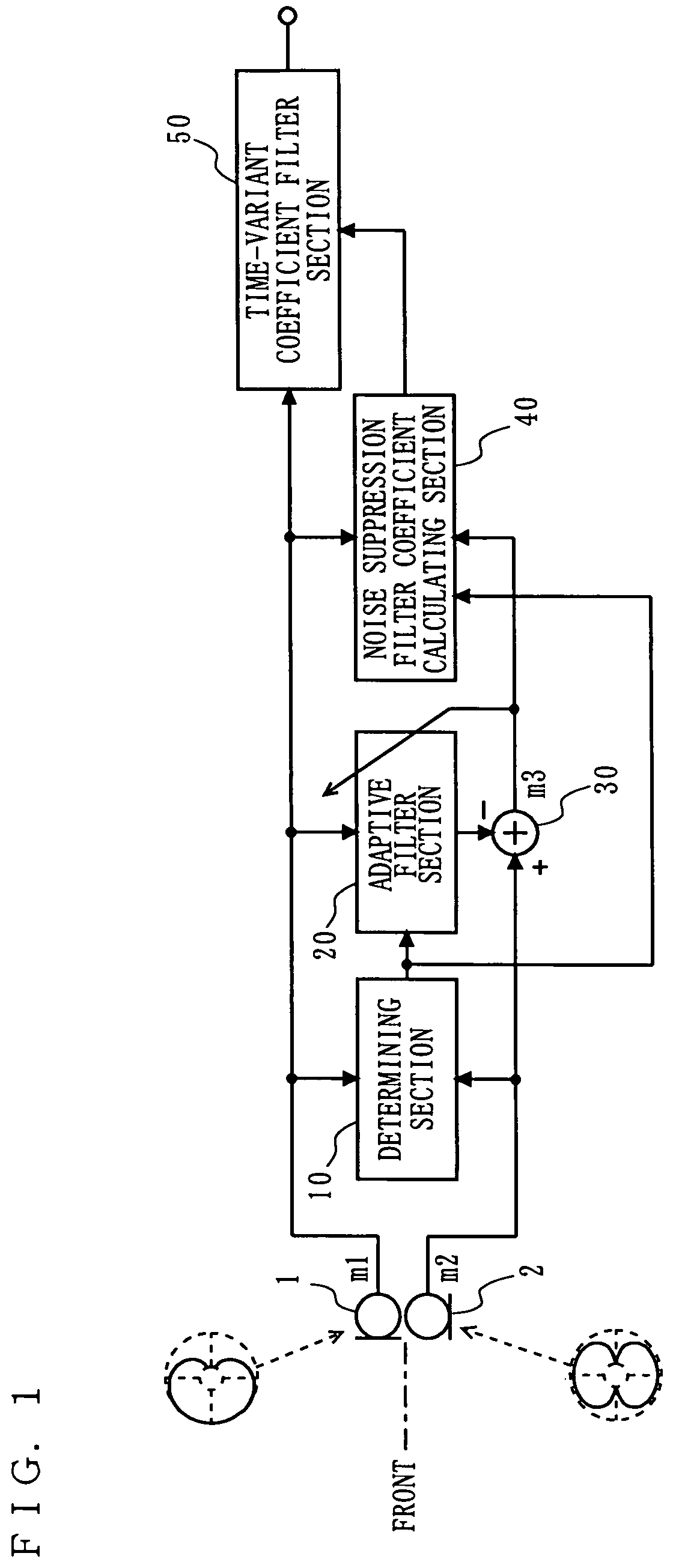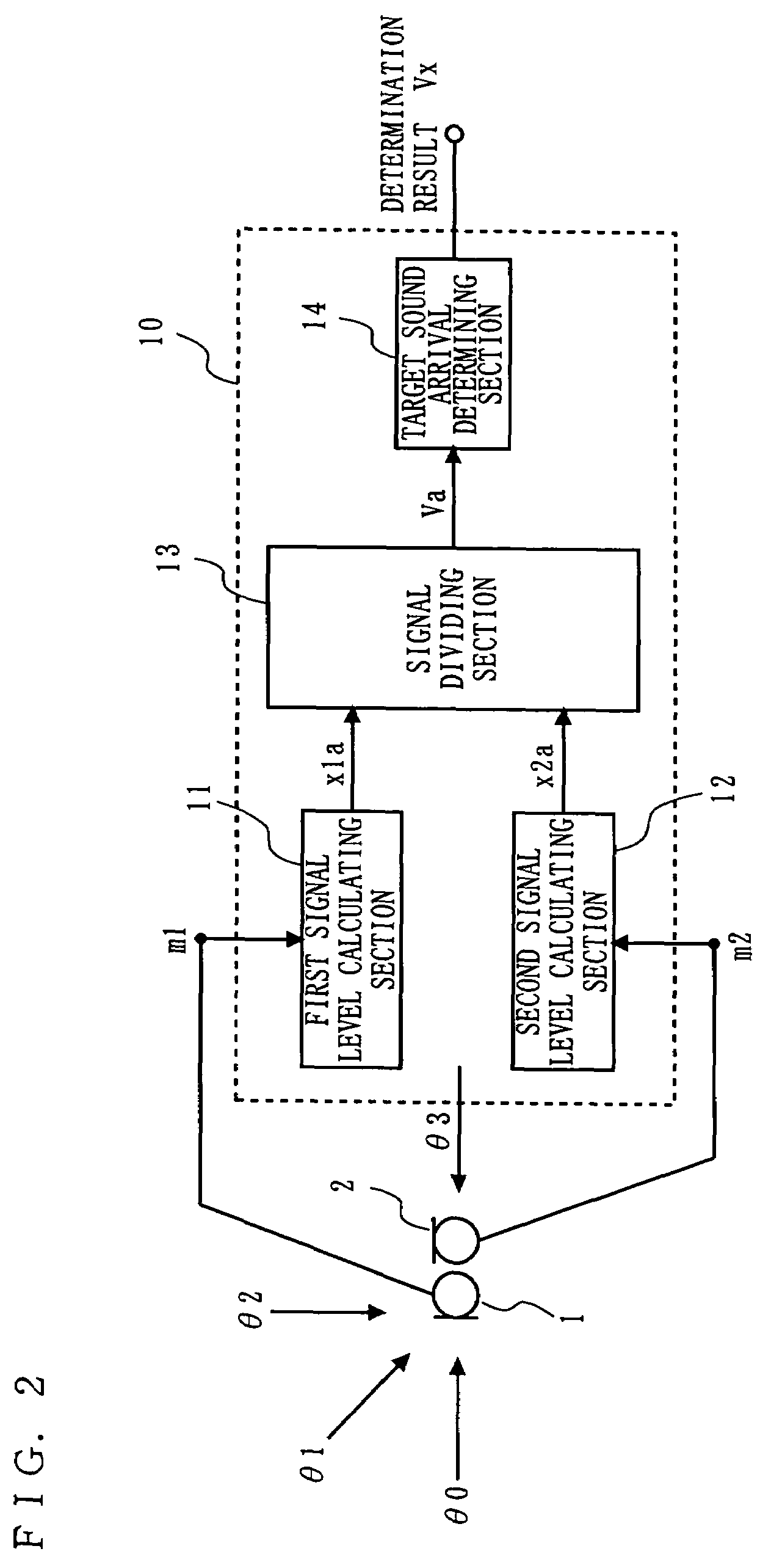Microphone device and audio player
a microphone and audio technology, applied in the direction of transducer casings/cabinets/supports, electrical transducers, transducers, etc., can solve the problems of microphone devices, 2 cannot achieve noise suppression effects, and the microphone devices of example 1 cannot handle noise coming from a plurality of directions, etc., to achieve stable operation and high s/n ratio
- Summary
- Abstract
- Description
- Claims
- Application Information
AI Technical Summary
Benefits of technology
Problems solved by technology
Method used
Image
Examples
embodiment 1
[0077]A microphone device according to Embodiment 1 of the present invention is described below with reference to FIGS. 1 through 7. FIG. 1 is a block diagram illustrating the configuration of the microphone device according to Embodiment 1. In FIG. 1, the microphone device includes a first microphone unit 1, a second microphone unit 2, a determining section 10, an adaptive filter section 20, a signal subtracting section 30, a noise suppression filter coefficient calculating section 40, and a time-variant coefficient filter 50.
[0078]In FIG. 1, the first microphone unit 1 is a unidirectional microphone unit, whose main axis of directivity is oriented to the front. The second microphone unit 2 is a bidirectional microphone unit, whose main axis of directivity is oriented so as to form a right angle with respect to the front direction. Note that the microphone device detects a sound coming from a desired direction. Hereinafter, a sound to be detected is referred to as a target sound, a...
embodiment 2
[0116]With reference to FIGS. 8 and 9, a microphone device according to Embodiment 2 is described below. In contrast of an object of the microphone device according to Embodiment 1, which is to suppress the included noise when detecting the target sound, an object of the microphone device according to Embodiment 2 is to correct distortion in frequency characteristic of the target sound caused by a detected reflected wave of the target sound.
[0117]In FIG. 8, the microphone device includes a first microphone unit 1, a second microphone unit 2, a determining section 10, an adaptive filter section 20, a signal subtracting section 30, a reflection information calculating section 60, and a reflection correcting section 70. Note that, in FIG. 8, components similar in structure to those in Embodiment 1 are provided with the same reference numerals, and are not described in detail herein.
[0118]In FIG. 8, the reflection information calculating section 60 is supplied with the filter coefficien...
embodiment 3
[0129]With reference to FIGS. 10 and 11, a microphone device according to Embodiment 3 is described below. The microphone device according to Embodiment 3 has a structure such that the structures of Embodiment 1 and 2 are combined.
[0130]FIG. 10 is a block diagram illustrating one example of the configuration of the microphone device according to Embodiment 3. In FIG. 10, the microphone device includes a first microphone unit 1, a second microphone unit 2, a determining section 10, an adaptive filter section 20, a signal subtracting section 30, a noise suppression filter coefficient calculating section 40, a time-variant coefficient filter section 50, a reflection information calculating section 60, and a reflection correcting section 70. Note that, in FIG. 10, components similar in structure to those in Embodiment 1 or 2 are provided with the same reference numerals, and are not described in detail herein.
[0131]The structure illustrated in FIG. 10 is different from that illustrated ...
PUM
 Login to View More
Login to View More Abstract
Description
Claims
Application Information
 Login to View More
Login to View More - R&D
- Intellectual Property
- Life Sciences
- Materials
- Tech Scout
- Unparalleled Data Quality
- Higher Quality Content
- 60% Fewer Hallucinations
Browse by: Latest US Patents, China's latest patents, Technical Efficacy Thesaurus, Application Domain, Technology Topic, Popular Technical Reports.
© 2025 PatSnap. All rights reserved.Legal|Privacy policy|Modern Slavery Act Transparency Statement|Sitemap|About US| Contact US: help@patsnap.com



